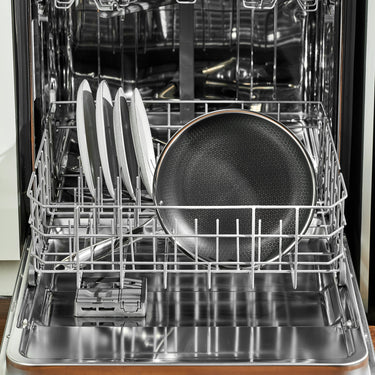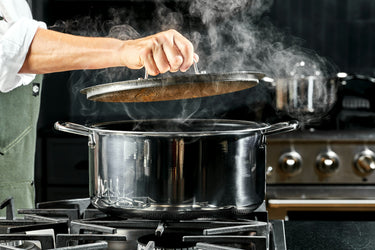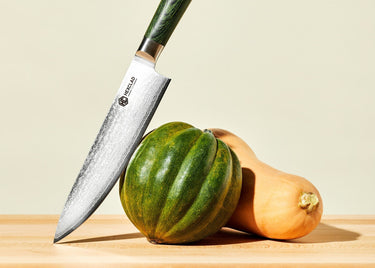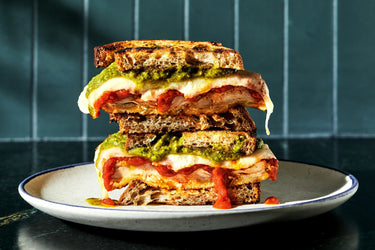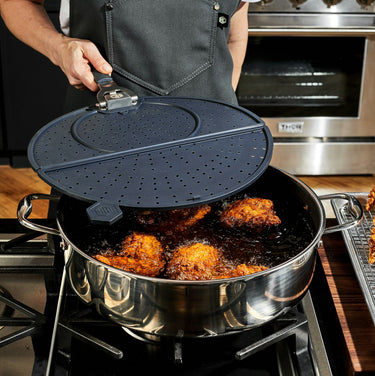The 12 Types of Knives Every Home Chef Should Have
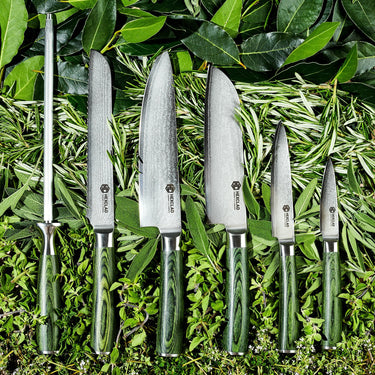
A lot of home chefs can feel bogged down by prep work, but having the right tools to take on each cutting task can make this part of the process quicker, easier, and safer.
With so many types of knives out there, where should we begin? How can you know which knives you really need in your cooking arsenal, and which ones are right for each chopping, dicing, and cutting job?
We’ve cooked up this guide to answer your questions and fuel you with all of the knife-related info you need to take on your next big dish.
Understanding the Different Parts of a Knife
While there are lots of different types of knives to choose from, they all typically have the same parts. Here’s the basic lingo to know when it comes to your kitchen knives:
The Blade
The blade of your knife is the part you use for cutting. The point, tip, edge, spine, and heel of a knife are all parts of the blade.
The Edge
This is the sharp side of the blade that does the cutting (and the side you don’t want to get your fingers too close to)! The edge of a knife can be serrated or straight.
The Spine
The spine refers to the unsharpened top side of the blade that runs parallel to the edge. The spine helps provide balance as you work, and typically a thicker spine has a stronger blade.
The Point
The point is the very tip of the knife, where the spine and edge meet at a sharpened point. The point of the knife is often used to pierce or score an ingredient.
The Tip
The tip of a knife refers to the front edge, right before you reach the point. The tip is best used for slicing and delicate cutting. The tip can be pointed or rounded, with pointed tips better for piercing and rounded tips better for slicing.
The Heel
The back end of the blade is known as the heel, and it is typically the widest part of a blade. The heel is used to provide added pressure when cutting through thick or tough foods.
The Tang
The tang is the part of the blade that connects to the handle. This unsharpened piece of the blade can go all the way to the end of the handle (“full tang”) or extend only partway into the handle (“partial tang”). Full tangs tend to provide more stability and strength, as they help balance and distribute weight throughout the knife.
The Handle
The handle or scale is the finger-friendly part of the knife we hold while cutting. Handles can be made out of various types of material and can feature different types of designs and shapes.
The Bolster
This important piece of the knife provides an added measure of safety as it creates a raised area between the blade and the handle. Along with helping keep the fingers from slipping down onto the blade, the bolster also helps balance and stabilize the knife with additional weight.
The Butt
The butt is the very end of the handle, which sits farthest away from the point of the knife.
What’s the Difference Between Forged and Stamped Knives?
Each knife you may find in any given kitchen has been crafted one of two ways: It has either been forged or stamped.
Forged knives are forged from a single piece of metal. The metal is hammered into the desired shape, which is then ground and honed to give it its edge. Once it is shaped and honed, the handle is added.
Forging the steel affects the material on the molecular level, creating a strong and durable blade.
Stamped knives, on the other hand, are made with stamping machines that stamp and cut a blade shape onto a single sheet of steel. A handle is added to the cut steel, and then the knife is hardened and sharpened. Stamped knives tend to be thinner and lighter than forged knives, and they may need to be sharpened more to keep the edge going strong.
One way to tell the difference between forged and stamped knives is that forged knives have a bolster, while stamped knives typically do not.
Forged knives tend to be stronger and more balanced, which is why all of our knives here at HexClad are forged.
Types of Knife Edges To Consider
The knife’s edge is what defines its sharpness and allows you to cut through the food, and different ingredients require different types of edges. Knowing which edge type is best for which task and having a variety of knives on hand help you master any recipe or dish.
Straight Edge
Knives with straight edges are the kind you’ll see most often. Also known as a flat ground edge, these edges are smooth and can slice smoothly through soft and hard ingredients alike. Chef’s knives, paring knives, and utility knives all feature straight edge blades.
Serrated Edge
As seen on bread knives, tomato knives, and steak knives, serrated blades have sharp teeth along their edge that can saw through tough foods or those with soft and delicate centers.
Scalloped Edge
Somewhat of a hybrid, a scalloped edge knife features a straight edge with dimples or scalloped indents running down the sides of the blade. Also known as a Granton edge knife, these indentations help keep food from sticking to the blade.
Scalloped edge knives are particularly useful when working with clingy ingredients such as raw fish or certain vegetables. You’ll see Granton edges on santoku knives and salmon knives.
Hollow Ground Edge
Hollow ground edges are extremely sharp, as they are ground on both sides of the blade to create a thin edge. Hollow ground edges can easily slice through a wide range of ingredients. Almost all nakiri knives have hollow ground edges to help you chop ingredients of all shapes, textures, and sizes.
What Types of Kitchen Knives Should I Have at Home?
Now that we’ve covered the basics, let's dive into the types of knives every home chef should stock and when to use them.
Chef’s Knife
The name says it all: Every chef relies on this mighty and versatile knife. Undoubtedly the best knife to have on hand for your day-to-day cooking, a chef's knife or cook’s knife is a go-to for so many vital kitchen tasks. Its long, curved blade allows you to rock the knife back and forth for easy slicing, chopping, mincing, and dicing.
The tip of the chef’s knife blade typically tapers into a fine point that can easily pierce and cut softer foods such as herbs or fleshy fruits. Meanwhile, the broad heel of a chef’s knife can help tackle thicker foods such as potatoes, hardy squashes, and more.
Whether you're making a quick and easy weeknight favorite or hosting a crowd, a well-made chef’s knife will quickly become your go-to in the kitchen.
Paring Knife
With a blade typically no longer than 3.5 inches, what paring knives lack in length they gain in confidence and precision. Similar to a small chef’s knife, these lightweight knives are easy to balance and control, and their sharp edge can help you master more intricate work such as peeling, deseeding, coring, and trimming. Paring knives are also ideal for crafting garnishes or deveining shrimp.
While a chef’s knife is more capable of slicing and chopping through tougher ingredients, a paring knife is better suited to perfect precision cutting and power you through prep work involving softer and smaller fruits and veggies.
Utility Knife
A bit smaller and thinner than a chef’s knife but longer than a paring knife, this kitchen staple comes in handy when chopping and slicing smaller or slightly tender ingredients. The sharp edge and pointed tip of the utility knife can slice through fruits, proteins, herbs, and sandwiches with ease, making this a multipurpose tool you won’t want to go without.
Boning Knife
Boning knives are known for their sharp and slim shape and are a great tool to have when handling meat on the bone (as you may have guessed by the name).
With a narrow blade and fine point, this sharp knife can work around the curves of bones and manage delicate maneuvers when separating meat from the bones or trimming cartilage. This will help limit waste as you cleanly remove the meat from the bone.
Boning knives are typically about six inches long and can be found in either flexible or firm varieties. Flexible blades can easily remove skin and bones from fish and poultry, while a stiff blade is your best bet when working with thick cuts of meat such as beef or pork.
Bread Knife
Bread knives are long and saw-like, thanks to the serrated teeth along their edge. This design allows the knife to saw through breads and other foods with soft or delicate centers without crushing them.
The serrated edge of the bread knife can provide grip and can easily saw through foods in a back and forth motion that doesn’t require the type of pressure that may break gentle interiors.
Along with effortlessly slicing bread and breaking it into hard-crusted loaves and baguettes, a bread knife can also make light work of cutting tomatoes, sponge cakes, apples, or bell peppers.
Cleaver
A cleaver is a large and imposing knife, containing a flat rectangular blade that hangs far below the handle. These broad and heavy knives are most commonly used to cut through raw meat, and can even slice through bones to help chop through raw meat. Creative cooks also use the flat side to crush garlic cloves or ginger.
You can find cleavers — also known as butcher knives — in various sizes to fit all of your meat-prepping needs.
Carving Knife
Also known as a slicing knife, the carving knife is one of the longest knives you’ll find in any chef’s collection. Long and slim, the carving knife’s sharp point and narrow width can cut clean and even slices in poultry, pork, lamb, or beef.
With a blade typically spanning about fifteen inches long, carving knives are also the perfect tool to take on the often intimidating task of slicing into large fruits and veggies such as melons or squashes.
Santoku Knife
If you want perfectly chopped, diced, or minced ingredients, look no further than the santoku knife.
Originally designed in Japan, the santoku knife has a long blade that tapers to a low point. The sheepsfoot design can create quick and precise cuts, while the dimpled blade keeps food from sticking to the knife as you cut. The wide blade can also be used to scoop ingredients with ease.
Santoku knives are commonly used for cutting raw fish, but this multi-purpose knife can also make quick work of veggies and fruits.
Fillet Knives
If you love a weekend fish fry, we recommend adding a fillet knife to your collection.
A fillet knife is typically long and slender with a sharp edge and flexible blade. The thin blade and ultra-fine tip is great for working with fish, as it can pierce through skin and get between the small bones for delicate removal, all while keeping the flesh intact. While a fillet knife resembles a boning knife, its blade is even more flexible and narrow.
Nakiri Knife
Also known as a Japanese vegetable knife, the nakiri knife is similar to a meat cleaver but smaller and thinner. The rectangular, straight blade drops below the handle, and its hollow-ground edge is incredibly sharp. This design makes the nakiri knife a powerful chopper capable of cutting through even the toughest veggies. A spaghetti squash is no match for a sharpened nakiri knife.
Many home cooks also opt for the nakiri knife when chopping, as the wide and rectangular blade allows you to chop straight through to the cutting board using swift up-and-down motions without needing to rock the blade back and forth as you go.
The nakiri’s sharp edge and flat blade can also make light work of shredding large greens such as lettuce and cabbages. With the ability to cut extremely thin slices evenly, the nakiri will come in handy when crafting veggie ribbons and garnishes, too.
Cheese Knife
Cheese and crackers can help warm up a crowd at a dinner party or serve as a scrumptious midday snack. Whether you're curating an elegant charcuterie board or making a mini cheese plate for one, you’ll want a cheese knife on hand when diving into this tasty snack.
Soft cheeses such as brie cheese are delightful, but their texture means they often stick to knives, causing a snag. Soft cheese knives feature holes in the blade that solve this problem by limiting the cheese’s surface contact with the knife, which helps reduce any sticking.
For harder cheeses like parmesan, a sharp cheese spade containing a pointed edge and sharp tip can easily slice through thick blocks of hard cheese.
While cheese knives make working with cheeses a breeze, don’t despair if you find yourself with many blocks and wheels of wonderful cheeses and no cheese knives to cut them with. You can make do with a small paring knife for firmer cheeses and a thin butter knife for softer cheeses.
Tomato Knife
Even the most experienced chefs among us have likely experienced the splatter of a tomato when trying to cut through the juicy, fleshy centers hidden beneath its delicate skin. If you apply too much pressure to or use a dull knife on a ripe tomato… forget about it. You’re done for.
Tomato knives are made to avoid that mess, as their sharp and serrated edge can cut cleanly through the skin without squashing the soft inside.
Tomato knives are long — often six to seven inches — but lightweight, so they are easier to control. Their blade is slightly curved with serrated edges to help slice through tomatoes, and their handles may be textured to provide added grip when working with these finicky fruits.
While tomato knives are worth adding to your home kitchen if you cook with tomatoes often, many cooks get by with a bread knife, as their sharp and serrated edges can provide similar support.
What’s the Best Material for Kitchen Knives?
Once you know which types of knives you want in your kitchen, you’ll need to decide on your preferred material. The materials used to craft a knife play a large role in its strength, durability, feel, and sharpness.
Stainless Steel Blades
Stainless steel blades are quite common, as they are durable and don’t typically rust or corrode. Stainless steel blades are made with carbon and iron, while chromium is added to give the blade its stain-repellent finish.
While stainless steel blades can be strong and durable, the quality varies greatly from one to the other, as some alloys (the mixtures of chemical elements that form the steel) are more cheaply made than others.
Carbon Steel Blades
The alloy of carbon steel blades includes carbon (no surprise there), a hard chemical element that can create a firmer blade. Carbon steel blades are often sharp and durable, capable of intricate precision cutting.
High carbon knives (those with more carbon content) are particularly hard and sharp but are also more likely to crack when placed under stress. Carbon steel knives also require more care, as the lack of chromium finish can lead to rusting if not cleaned and stored properly.
Damascus Steel Blades
Damascus steel blades are crafted by hammering multiple iron-based steel alloys together to create strong forged steel. Damascus steeloften features complex, waving patterns on the blade formed by the merging of multiple steels.
The layers of steel create an extremely strong and durable blade that can outlive many other types of steel. These alluring, long-lasting knives will also retain their shape and sharp edges for years to come. (That being said, you should regularly sharpen your knives regardless of material to keep them at their peak performance and lower your risk of injury.)
Elevate Your Kitchen Collection With HexClad
At HexClad, we forge our knives from 67 layers of high-quality Japanese Damascus steel, providing you with a hard blade and sharp edge for all of your slicing and dicing needs. All of our knives feature a full-tang construction to provide superior balance and control.
Our six-piece knife set includes a chef’s knife, paring knife, utility knife, bread knife, and santoku knife, giving you a variety of edge types to dominate any ingredient thrown your way. A honing rod is also included to help you keep your knives sharp and functioning at their finest.
With an elegant wave pattern across the blade and unique forest green pakkawood handles, these knives will not only help you master any and every meal, but will also add a striking statement to your kitchen.
Bottom Line
Having the right knife for each cutting task and understanding more about the build and purpose of each knife in your collection will help make cooking easier, faster, safer, and more stress-free.
With HexClad’sJapanese Damascus Steel knife set, you’ll be soaring through prep work and enjoying your meal in no time.
Sources
Damascus Steel Facts: How It Got Its Name and How It's Made | ThoughtCo
